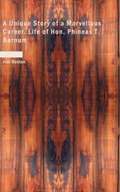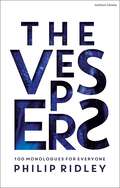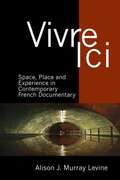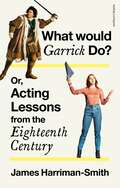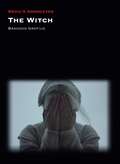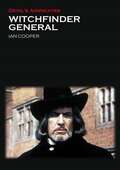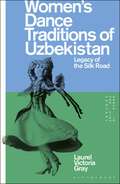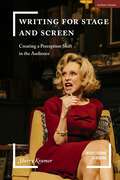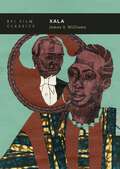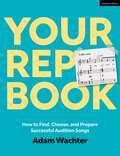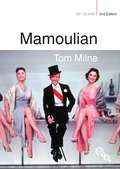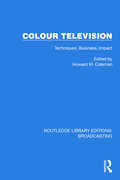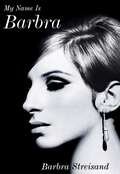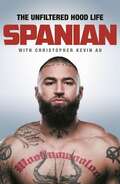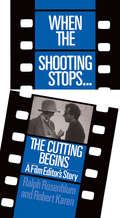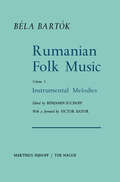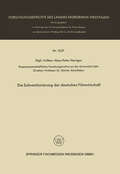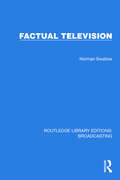- Table View
- List View
A Unique Story of a Marvellous Career: Life of Hon. Phineas T. Barnum
by Joel BentonThere is none that stands for more notable success in his chosen line none that recalls more memories of wholesome entertainment none that is more invested with the fragrance of kindliness and true humanity.
The Vespers: 100 Monologues for Everyone (Audition Speeches)
by Philip RidleyHave you ever struggled to find the perfect monologue?Do you want to lose yourself in an unforgettable story?Do you want to be…transported?Philip Ridley's The Vespers is a major work by a major writer. 100 original, self-contained monologues for actors (and readers) of all genders, all ages, and all levels of experience. Varying in length, style and structure – from the surreally comic to the heartbreakingly tragic – this is an essential toolkit for any actor (or anyone who enjoys a good story) with an introduction by Cath Badham, Lecturer in Performance at the University of Derby, UK.
Visions of Aging: Images of the Elderly in Film
by Amir Cohen-ShalevThe interface of old age and cinema provides a fascinating yet uncharted territory in the humanities and social sciences. Two central perspectives are explored: movies on old age by old filmmakers; and movies on old age by younger artists. The first perspective focuses on the cinematic representation of ageing from within, whereas the second examines the ways ageing is viewed from the outside. The distinction is based on the schism between the phenomenology of ageing and its social representation: The one hinges on intrinsic qualities of 'old age style' or 'late style'; the second addresses attitudes towards old age in general as well as towards ageing artists and the reception (or rejection) of their late films. The author combines these general perspectives as it shifts between text and context, beginning with ageing from the outside in order to introduce the semantics and pragmatics of the context (reception and filmmaking stylistic change, midlife images of old age), and continuing into the world of ageing as cinematically represented from within, by old filmmakers, an often idiosyncratic, metaphysical and sometimes unapproachable world. By providing a roadmap that charts previous scholarly paths of inquiry, this book offers a panoramic view of the direction of this new field of cinematic gerontology, and is essential reading for students and scholars of cinema, humanistic gerontology, psychology of art, and the sociology of old age and popular culture.
Vivre Ici: Space, Place and Experience in Contemporary French Documentary (Contemporary French and Francophone Cultures #50)
by Alison J. Murray LevineVivre Ici invites the reader on a journey through the vast viewing landscape of contemporary French documentary film, a genre that has experienced a renaissance in the past twenty years. The films explored are connected not just by a general interest in engaging the “real,” but by a particular attention to French space and place. From farms and wild places to roads, schools, and urban edgelands, these films explore the spaces of the everyday and the human and non-human experiences that unfold within them. Through a critical approach that integrates phenomenology, film theory, eco-criticism and cultural history, Levine investigates the notion of documentary as experience. She asks how and why, in the contemporary media landscape, these films seek to avoid argumentation and instead, give the viewer a feeling of “being there.” As a diverse collection of filmmakers, both well-known and lesser-known, explore the limits and possibilities of these places, a collage-like, incomplete, and fragmented vision of France as seen and felt through documentary cameras comes into view. Venturing beyond film analysis to examine the production climate for these films and their circulation in contemporary France, Levine explores the social and political consequences of these “films that matter” for the viewers who come into contact with them.
What Would Garrick Do? Or, Acting Lessons from the Eighteenth Century
by James Harriman-SmithThe stage of the 1700s established a star culture, with the emergence of such acting celebrities as David Garrick, Susannah Cibber, and Sarah Siddons. It placed Shakespeare at the heart of the classical repertoire and offered unprecedented opportunities to female actors. This book demonstrates how an understanding of the practice and theories circulating three hundred years ago can generate new ways of studying and performing plays of all kinds in the present.Eight short essays – on emotions, cultivation, character, voice, action, company, audience, and reflection – provide two things: a vivid introduction to the practice and ideas of the eighteenth-century stage, and the story of how these past practices and ideas were used in collaborative workshops around the UK to create new rehearsal exercises. Designed to work alone or in combination, these exercises are also open to further adaptation and analysis as part of a work that treats theatre writers of the past as potential collaborators for those interested in theatre today. Marrying academic and professional theatre expertise, this book ranges through a vast archive of writing about acting, from private letters and battered promptbooks, through to philosophical treatises and celebrity biographies. The exercises, stories, and ideas shared here capture the strangeness of this material – and sometimes its surprising familiarity, as questions asked of actors then seem to anticipate those questions we ask now. A truly unique offering, What would Garrick Do? Or, Acting Lessons from the Eighteenth Century offers a fascinating deep-dive into an important time in theatre history to illuminate practices and processes today.
The Wicker Man (Devil's Advocates)
by Steve WigginsMany fans of Robin Hardy’s The Wicker Man (1973) may know that this classic is considered a fine sample of folk horror. Few will consider that it’s also a prime example of holiday horror. Holiday horror draws its energy from the featured festive day, here May Day. Sergeant Neil Howie (Edward Woodward), a “Christian copper,” is lured to the remote Scottish island Summerisle where, hidden from the eyes of all, a thriving Celtic, pagan religion holds sway. His arrival at the start of the May Day celebration is no accident. The clash between religions, fought on the landscape of the holiday, drives the story to its famous conclusion. In this Devil’s Advocate, Steve A. Wiggins delineates what holiday horror is and surveys various aspects of “the Citizen Kane of horror movies” that utilize the holiday. Beginning with a brief overview of Beltane and how May Day has been celebrated, this study considers the role of sexuality and fertility in the film. Conflicting with Howie’s Christian principles, this leads to an exploration of his theology as contrasted with that of Lord Summerisle (Christopher Lee) and his tenants. Such differences in belief make the fiery ending practically inevitable.
The Witch (Devil's Advocates)
by Brandon GrafiusRobert Eggers' The Witch (2015) is one of the most critically acclaimed horror films of recent years, praised as a genre film of unusual depth which eschews jump scares in favour of a gradually and steadily building tension. Set in newly colonized New England in the early seventeenth century, the film’s deep historical and mythological background, as well as its complicated and interlocking character arcs, make for a film whose viewers will be well served by this Devil’s Advocate, the first stand-alone critical study of the film. As well as providing the historical and religious background necessary for a fuller appreciation, including an insight into the Puritan movement in New England Brandon Grafius situates the film within a number of horror sub-genres (such as folk horror) as well as its other literary and folkloric influences.
Witchfinder General (Devil's Advocates)
by Ian CooperWitchfinder General (1968), known as The Conqueror Worm in America, was directed by Michael Reeves and occupies a unique place in British cinema. Equally praised and vilified, the film fictionalizes the exploits of Matthew Hopkins, a prolific, real-life "witch hunter," during the English Civil War. For critic Mark Kermode, the release proved to be "the single most significant horror film produced in the United Kingdom in the 1960s," while playwright Alan Bennett called the work "the most persistently sadistic and rotten film I've ever seen." Steadily gaining a cult reputation, unimpeded by the director's death just months after the film's release, the film is now treated as a landmark, though problematic, accomplishment, as it exists in a number of recut, retitled, and rescored versions. This in-depth study positions the film within the history of horror and discusses its importance as a British and heritage film. It also considers the inheritance of Hopkins, the script's relationship to the novel by Ronald Bassett, and the iconic persona of the film's star, Vincent Price. Ian Cooper conducts close textual readings of specific scenes and explores the film's various contexts, from the creation of the X certificate and the tradition of Hammer gothic, to the influence on Ken Russell's The Devils (1971) and the "torture porn" of twenty-first-century horror.
Women and Migration in Contemporary Italian Cinema: Screening Hospitality (Transnational Italian Cultures #7)
by Giovanna Faleschini LernerWomen and Migration in Contemporary Italian Cinema: Screening Hospitality puts gender at the centre of cinematic representations of contemporary transnational Italian identities. It offers an intersectional feminist analysis of the ways in which transnational migration has been represented, understood, and constructed in the contemporary cinema of Italy. Drawing on Jacques Derrida’s notion of hospitality and in dialogue with postcolonial and decolonial theory, queer studies, and feminist critiques, the six chapters of the book focus on a series of exemplary fiction films from the last twenty years, which both reflect and shape the nation’s responses to the growing presence of transnational migrants in Italian society. The book shows how questions of gender, sexual difference, and reproductivity have been central to Italian filmmakers’ approaches to stories of mobility and displacement. Gender is also enmeshed in the rhetoric and poetic of hospitality that filmmakers propose as a critical framework to condemn Italian border policies and politics. Women and Migration in Contemporary Italian Cinema: Screening Hospitality traces an arc that moves from the embrace of a humanitarian rhetoric of infinite hospitality toward migrants, apparent in films produced in the early 2000s, to a more fluid understanding of Italian identities from a transnational perspective.
Women’s Dance Traditions of Uzbekistan: Legacy of the Silk Road (Dance in the 21st Century)
by Laurel Victoria GrayThe first comprehensive work in English on the three major regional styles of Uzbek women's dance – Ferghana, Khiva and Bukhara – and their broader Silk Road cultural connections, from folklore rootsto contemporary stage dance. The book surveys the remarkable development from the earliest manifestations in ancient civilizationsto a sequestered existence under Islam; from patronage under Soviet power to a place of pride for Uzbek nationhood. It considers the role that immigration had to play on the development of the dances; how women boldly challenged societal gender roles to perform in public; how both material culture and the natural world manifest in the dance; and it illuminates the innovations of pioneering choreographers who drew from Central Asian folk traditions, gestures and aesthetics – not Russian ballet – to first shape modern Uzbek stage dance. Written by the first American dancer invited to study in Uzbekistan, this book offers insight into the once-hidden world of Uzbek women's dance.
Writing for Stage and Screen: Creating a Perception Shift in the Audience (Introductions to Theatre)
by Sherry Kramer"This book does what no other playwriting book in my experience has done, it offers a new way of seeing and conceiving how theatre makes meaning and carries emotional impact in performance."Suzan Zeder, Professor Emerita and former Head Of Playwriting at University of Texas at Austin, USACombining a step-by-step analysis of the technique of writing for stage and screen with how the mystery, poetry, and emotional momentum is achieved for the audience, Sherry Kramer offers an empowering, original guide for emerging and established writers. In this structured look at the way audience members progress through a work in real time, Sherry Kramer uses plain-spoken vocabulary to help you discover how to make work that will mean more to your audiences. By using examples drawn from plays, film, and streaming series, ranging from A Streetcar Named Desire to Fleabag to Pirates of the Caribbean, this study makes its concepts accessible to a wide range of artists who work in timebound art. The book also features multiple exercises, developed with MFA writers in The Iowa Playwrights Workshop and The Michener Center for Writers, where Kramer taught for the past 25 years, which provide entrance points to help you consider and create your work.
Writing Resistance in Northern Ireland
by Aimée WalshWriting Resistance in Northern Ireland is an examination of feminist republicanism(s) in the north of Ireland between 1975 and 1986. Republican prison protest was rife during this period, and fractures opened up between the feminist and republican movements. Despite their shared objective of self-determination, the two movements did not achieve a natural or total congruence. While it has been argued that there is a disjuncture between feminism and nationalism, this book argues for a new perspective on feminist republicanism(s) in the north and tells the story of a niche collective of republican feminists who came to the fore during the Troubles and sought bodily, political and economic autonomy. The book examines source material including historical narratives, jail-writings, journalism, documentary film and literary texts, and paints a vivid picture of a movement of republican feminist women’s writing concerned with political crisis, gender and the nation. Aimée Walsh uses the plural ‘republicanism(s)’ as a way of encapsulating the varied iterations of nationalist feminism, from militant republicanism in Armagh Gaol to a non-violent literary nationalist feminism. This examination of the interaction between nationalism and gender shows how the study of women’s writing can offer a paradigm shift in the history of the Troubles as seen through a feminist lens.
Xala (BFI Film Classics)
by James S. WilliamsXala (1974) by the pioneering Senegalese director Ousmane Sembene, was acclaimed on its release for its scorching critique of postcolonial African society, and it cemented Sembene's status as a wholly new kind of politically engaged, pan-African, auteur film-maker. Centring on the story of businessman El Hadji and the impotence that afflicts him on his marriage to a young third wife, Xala vividly captures the cultural and political upheaval of 1970s Senegal, while suggesting the radical potential of dissent, solidarity and collective action, embodied by El Hadji's student daughter Rama and the group of urban 'undesirables' who act as a kind of raw chorus to the affairs of the neocolonial elite. James S. Williams's lucid study traces Xala's difficult production history and analyses its daring combination of political and domestic drama, oral narrative, social realism, symbolism, satire, documentary, mysticism and Marxist analysis. Yet from its dazzling extended opening sequence of revolution as performance to its suspended climax of redemption through ritualised spitting, Xala presents a series of conceptual and formal challenges that resist a simple reading of the film as allegory. Highlighting often overlooked elements of Sembene's intricate, experimental film-making, including provocative shifts in mood and poetic, even subversively erotic, moments, Williams reveals Xala as a visionary work of both African cinema and Third Cinema that extended the parameters of postcolonial film practice and still resounds today with its searing inventive power.
Yankee Doodle Dandy: George M. Cohan and the Broadway Stage (Broadway Legacies)
by Elizabeth T. CraftPlaywright, composer, actor, director, and producer George M. Cohan looms large in musical theater legend. Remembered today for classic tunes like "You're a Grand Old Flag" and "Give My Regards to Broadway," he has been called "the father of musical comedy," and his statue stands in the heart of the New York theater district. Cohan's early twentieth-century shows and songs captured the spirit of an era when staggering social change gave new urgency to efforts to define Americanism. He was an Irish American who had the audacity to represent himself as the Yankee Doodle emblem of the nation, a vaudevillian who had the nerve to unapologetically climb the ranks and package his lower-brow style as Broadway. In Yankee Doodle Dandy, the first book on Cohan in fifty years, author Elizabeth T. Craft situates Cohan as a central figure of his day. Examining his multifaceted contributions and the various sociocultural identities he came to embody, Craft shows how Cohan and his works indelibly shaped the American cultural landscape. Informative and engaging, this book offers rich reading for Broadway musical aficionados as well as scholars of musical theater and American cultural history.
Your Rep Book: How to Find, Choose, and Prepare Successful Audition Songs
by Adam WachterPrepping songs for Musical Theatre auditions can be more stressful and confusing than a bad production of Sweeney Todd... but this book can help. How do you find the right songs, and in all the various genres? Where do you get the sheet music? How do you edit it down to make your 16- or 32-bar cut? What even is a 16-bar cut?! Relax, diva: Your Rep Book has the answers to all these questions and so many more. Adam Wachter has taught courses on audition repertoire selection at top conservatories in the US and UK and spent years accompanying and sitting “behind the table” in auditions for everything from university programs to Broadway shows. This friendly and accessible guide is designed to answer all your questions and help you stock that rep book with tight cuts of great songs so you can walk into your next audition and totally nail it. Including a foreword by Broadway casting director Rachel Hoffman and an afterword by Broadway and West End star Caissie Levy, Your Rep Book takes its readers step-by-step through the strangely mysterious process of building your audition repertoire portfolio (or “rep book” in industry jargon). Leaving no stone – or showtune – unturned, it helps you identify what songs you need in which categories and explains where to find them, how to source and cut the sheet music, and even how to communicate effectively with the accompanist and act your song. Whether you're a high school student auditioning for college MT programs or the ink is still wet on your recent BFA, or even if you're a seasoned pro dusting off those old charts, Your Rep Book is here to help!
Mamoulian (BFI Silver)
by Tom MilneThe great Armenian-American director Rouben Mamoulian (1897-1987) remains a favourite among film-makers, his films combining great technical originality with a uniquely poetic visual style. Mamoulian's technical innovations are evident from his first film, Applause (1923), in which he incorporated two separate soundtracks into one printing, thus overcoming the difficulty of sound levels which had frustrated the pioneer directors of 'talkies', and in Dr Jekyll and Mr Hyde (1931), in which he used synthetic sound painted directly onto the soundtrack. Such inventive solutions to film-making challenges were linked to Mamoulian's abiding sense of the magic of the cinema. Heused colour as a dramatic ingredient in the first three-strip Technicolour film, Becky Sharp (1935), and his musicals Summer Holiday (1948) and Silk Stockings (1957) were remarkable in their time for the way in which the dance was used to enhance the drama and to illuminate character. And for Garbo, in Queen Christina (1933) he created the framework for her greatest role. Tom Milne's classic study, first published in 1969, provides a film-by-film analysis of Mamoulian's career and challenges widespread critical assumptions about the director's oeuvre. In his foreword to this new edition, Geoff Andrew recognises Milne's careful and insightful analysis of Mamoulian's expressive and imaginative style and asks whether this unique director ought to be considered as an auteur. Andrew also pays tribute to Milne's elegant, witty and eclectic critical style and hails him as one the most important and influential British writers on film.TOM MILNE (1926-2005) was a leading British film critic, contributing to Sight & Sound, the Monthly Film Bulletin, The Observer, The Financial Times and The Times during his career. During the 1960s he worked at the British Film Institute as Associate Editor of Sight & Sound and Editor of The Monthly Film Bulletin. His other publications include a monograph on Joseph Losey (1967), a short study on the Danish director Carl Theodor Dreyer (1971) and an anthology of interviews and writings on Jean-Luc Godard (1972) that he edited and translated.Foreword by GEOFF ANDREW, Head of Film Programme at BFI Southbank, UK, and the author of several books including Nicholas Ray: Poet of Nightfall (BFI, 2004) and, in the BFI Film Classics series, volumes on Kieslowski's Three Colours Trilogy and Kiarostami's 10.
Colour Television: Techniques, Business, Impact (Routledge Library Editions: Broadcasting #17)
by H.W. ColemanColour Television (1968) examines the rapid growth of colour television in the 1960s as technological advances enabled programmes to be effectively transmitted in colour for the first time. It looks at the technologies involved, the differences in programme-making that colour required, the audience response, and the changes in advertising and network systems that colour broadcasting brought about.
Colour Television: Techniques, Business, Impact (Routledge Library Editions: Broadcasting #17)
by H.W. ColemanColour Television (1968) examines the rapid growth of colour television in the 1960s as technological advances enabled programmes to be effectively transmitted in colour for the first time. It looks at the technologies involved, the differences in programme-making that colour required, the audience response, and the changes in advertising and network systems that colour broadcasting brought about.
My Name is Barbra: The exhilarating and startlingly honest autobiography of the living legend
by Barbra StreisandThe long-awaited memoir by the superstar of stage, screen, recordings, and television'Exhilarating … leaves blood on the page … My Name Is Barbra is 992 pages of startling honesty and self-reflection, deadpan parenthetical asides (including a running bit about how much she loves going to the dentist), encyclopedic recall of onstage outfits, and rigorous analyses of her films’ Vanity FairBarbra Streisand is by any account a living legend, a woman who in a career spanning six decades has excelled in every area of entertainment. She is among the handful of EGOT winners (Emmy, Grammy, Oscar, and Tony) and has one of the greatest and most recognizable voices in popular music. She has been nominated for a Grammy 46 times, and with Yentl she became the first woman to write, produce, direct, and star in a major motion picture. In My Name Is Barbra, she tells her own story about her life and extraordinary career, from growing up in Brooklyn to her first star-making appearances in New York nightclubs to her breakout performance in Funny Girl (musical and film) to the long string of successes in every medium in the years that followed. The book is, like Barbra herself, frank, funny, opinionated, and charming. She recounts her early struggles to become an actress, eventually turning to singing to earn a living; the recording of some of her acclaimed albums; the years of effort involved in making Yentl; her direction of The Prince of Tides; her friendships with figures ranging from Marlon Brando to Madeleine Albright; her political advocacy; and the fulfillment she's found in her marriage to James Brolin.No entertainer's memoir has been more anticipated than Barbra Streisand's, and this engrossing and delightful book will be eagerly welcomed by her millions of fans.
Spanian: The Unfiltered Hood Life
by SpanianBy the time he was twelve, Spanian knew he would follow his family's footsteps to become a career criminal. What followed was a decade-long string of brazen crimes and brutal violence: stabbings, ram-raids, drug runs and a notorious high school siege. Throughout the Sydney social housing enclaves of Redfern, Waterloo and Woolloomooloo, Spanian earned a reputation as one of the city's most flagrant crooks; armed with a boxcutter in one hand, and a syringe in the other.But it all came at a damning price: in the throes of heroin addiction and thirteen years wasted behind bars, Spanian became a longstanding resident of jails across New South Wales. There, he was embroiled in racial divisions, prison politics, and a vicious vortex of self-destruction, until music and books became an unlikely lifeline. Reading and rapping became new rituals, and a glistening light at the end of the tunnel. Released from Bathurst Correctional Centre in 2017 with newfound purpose, Spanian has since found viral fame and a sprawling, worldwide audience through hip-hop and his magnetic social media presence.This is the powerful, unflinching and high-octane memoir of how a young inner-city kid became Spanian. It gives unapologetic insight into the gritty socio-economic underbelly of Sydney city, the criminal justice system, and the correctional system. The story of Spanian provides hope that even the most stubborn cycles can be broken, and new dreams made.
When The Shooting Stops ... The Cutting Begins: A Film Editor's Story
by Ralph Rosenblum Robert KarenThe story of one of the most important and least-understood jobs in moviemaking-film editing-is here told by one of the wizards, Ralph Rosenblum, whose credentials include six Woody Allen films, as well as The Pawnbroker, The Producers, and Goodbye, Columbus. Rosenblum and journalist Robert Karen have written both a history of the profession and a personal account, a highly entertaining, instructive, and revelatory book that will make any reader a more aware movie-viewer.
Rumanian Folk Music: Instrumental Melodies (Bartok Archives Studies in Musicology #1)
by Bela Bartokn several of his writings on folk music Bela Bart6k recalls an incident I that happened to him in 1904 during a visit to a small village in Tran 1 syl vania. Quite by chance he heard there an eighteen-year-old Hun garian peasant girl singing Hungarian folk songs whose construction was 2 significantly different from the songs he had known until then. This experience appealed to his imagination far deeper than chance oc currences usually do. It sparked in him a creative fire that was there after to impart to his music certain characteristics that are recognizable today as indigenous to the Bart6kian style of composition. The inspirational value of the incident was rekindled by return trips to Transylvania. During these trips he was not merely listening. He began notating, melodies, building them into a coordinated collection. Soon Bart6k's itinerary took him into villages populated in checkered proximity by both Hungarians and Rumanians, thence into little communities where the population was exclusively Rumanian. There he discovered that their songs were much less, if at all, influenced by the urban civilization of Western Europe than those he had collected in Hungarian villages. In an interview he gave to a Transylvanian newspaper in 1922, Bart6k described the difference between the available Hungarian and Rumanian songs.
Die Subventionierung der deutschen Filmwirtschaft (Forschungsberichte des Landes Nordrhein-Westfalen #1637)
by Hans-Peter HerrigerIn der deutschen Filmwirtschaft haben wir einen Wirtschafts zweig vor uns, dem es bis heute, fast 20 Jahre nach der totalen Zerstörung durch den 2. Weltkrieg, noch nicht gelungen ist, sich den veränderten wirtschaftlichen Bedingungen an zupassen. Der Versuch einer wirtschaftlichen Stabilisierung nach den radikalen Beschränkungen der Besatzungsmächte und die sich abzeichnende Erholung fiel zusammen mit der Entstehung einer übermächtigen Substitutionskonkurrenz. Die deutsche Filmwirtschaft war zu diesem Zeitpunkt wirtschaftlich noch zu wenig gefestigt, um die mit der Konkurrenz zwischen Fernsehen und Film offen sichtlich werdende Struktur krise aus eigenen Kräften überwinden zu können. Diese bisher schwerste Krise der Filmwirtschaft ist allerdings nicht allein eine Folge dieser Konkurrenzsituation. Bisher begangene Fehler und Mängel der Filmwirtschaft machten sich erst in dieser Situation besonders gravierend be merkbar. Wenn auch Krisen bisher in der Geschichte der deutschen Filmwirt l schaft nicht unbekannt sind , so scheint die heutige Strukturkrise jedoch in der Lage zu sein, diesen Wirtschaftszweig in seinem Bestand zu gefährden. Gelingt es der deutschen Filmwirtschaft nicht, die Strukturwandlung, ob mit oder ohne äußere Hilfe, zu überwinden und in privatwirtschaftlichem Rahmen unter ver änderten Bedingungen weiter zu bestehen, so erleidet sie möglicherweise das gleiche Schicksal wie das Kulturtheater durch das Aufkommen des Films in den An fängen dieses Jahrhunderts 2.
Factual Television (Routledge Library Editions: Broadcasting #20)
by Norman SwallowFactual Television (1966) looks at the techniques and purpose of all facets of factual television – news and current affairs programmes; documentaries; reporting stories; the ethics of reporters and producers. It quotes at length from television writers, producers and television executives, to give very much an insider’s view of the arena.
Factual Television (Routledge Library Editions: Broadcasting #20)
by Norman SwallowFactual Television (1966) looks at the techniques and purpose of all facets of factual television – news and current affairs programmes; documentaries; reporting stories; the ethics of reporters and producers. It quotes at length from television writers, producers and television executives, to give very much an insider’s view of the arena.
